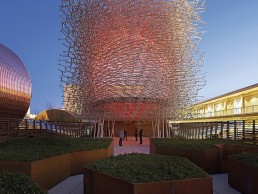
UK Pavilion, World Expo, Italy
The UK Pavilion highlights the decline of the world’s bee population and the importance of pollination for food production, looking at how new UK research and technology are helping to address challenges such as food security and biodiversity. Designed by an all British team – Nottingham-based artist Wolfgang Buttress with engineering from Simmonds Studio and the Manchester office of BDP who’s lighting team, consisting of Rhiannon West, Chris Lowe and Colin Ball, provided the lighting design – the pavilion is an homage to the ground-breaking UK technology developed by physicist and bee expert Dr. Martin Bencsik.
The bees’ activities are monitored from the roof of Nottingham Trent University by Bencsik using accelerometers to detect and translate the vibrations made by bees as they communicate with one another. Visitors meander through an orchard, discover a meadow of wild flowers and enter the Hive, which pulses, buzzes and glows according to live-streamed signals from a real beehive in the UK. The accelerometers are used to measure the activity of the colony and algorithms are used to convert the bee colony vibrations into lighting effects. The concept, designed by Wolfgang Buttress, consists of 1,000 individually-addressable bespoke RGBW LED pixels (custom-made and integrated into the Hive engineered by UK manufacturer Stage One) allowing the Hive to pulse and glow, acting as a visual representation of bee activity.
Rhiannon West commented: “Our lighting vision from the start was integration of lighting within the landscape and architecture. We wanted to be seamless right from day one. We wanted light only where it was required; maintaining incredibly low levels of light whilst ensuring sufficient light is available to all required tasks.”
BDP needed to keep in mind low viewing angles and glare. The journey from beginning to end was intended to replicate a ‘waggle dance’ – a movement bees make to signal the direction of pollen to one another. This route by night comes alive with glowing pathways being the only source of lighting. Following the light takes you on a journey to the pavilion’s main attraction, the Hive.”
Due to the low levels of light in the centre of the Hive, BDP took care to reduce ambient light levels and minimise glare. This is achieved through luminaires integrated within details, ensuring that visitors’ eyes adapt as soon as they arrive. The Pavilion has various functions and the lighting design ensures that the systems for the bar, dining and conference spaces, together with the wayfinding and emergency lighting, integrate seamlessly into Buttress’s vision whilst maintaining incredibly low levels of light. Entering the Pavilion, the orchard’s pathways glow gently leading to the meadow where a series of trees are uplit and visitors are guided past a busy ‘swarm wall’ emanating a slight sparkle.
Visitors move around the meadow pathways in the formation of the ‘waggle dance’ all lit from a low level skirting detail. Over 600m of British company Lumenal’s Mira 7mm deep aluminium profile, integrated with iGuzzini LED, is used at ankle level around the honeycomb shaped walkways, the bar areas and into handrails to give a warm, honey like-glow. Below the hive deep recessed, low glare adjustable spotlights from Light Projects (also from the UK) provide pools of light to aid the reading of brochures and offsetting the drama of the animated Hive overhead.
Inside the heart of the building lies a decorative beehive-inspired lighting installation. This is a show space for fine dining, conference and government hosting, and the installation offers a variety of flexible lighting for each. An array of hexagonal aluminium extrusions from Scottish manufacturer (still part of the UK, just!), Mike Stoane Lighting (MSL), are scattered in small clusters over the ceiling, each providing a warm white glow with a slight sparkle using 2200K Cree chips.
Dave Hollingsbee, Mike Stoane Lighting’s Managing Director, was clearly buzzing about the project: “We were delighted to be approached by BDP to help with the lighting of the inner hub. The brief was relatively flexible and open to suggestion, providing the result was very rich and warm and in the vein of a honeycomb.”
West is extremely happy with how the project panned out: “We developed a great working relationship with Wolfgang and this was fundamental to the success of the scheme. I enjoy focusing on the unique relationship between light and architecture, especially developing ideas where the atmosphere and experience of space become more important than the materials. This is a perfect example of that.”
The UK Pavilion is intended to be an exemplar of British design quality and ingenuity. It’s all-British cast has blazed a trail at the Milan Expo with many critics lauding the pavilion as the most creative concept on site. And all done on time too. It makes one proud to be British!



